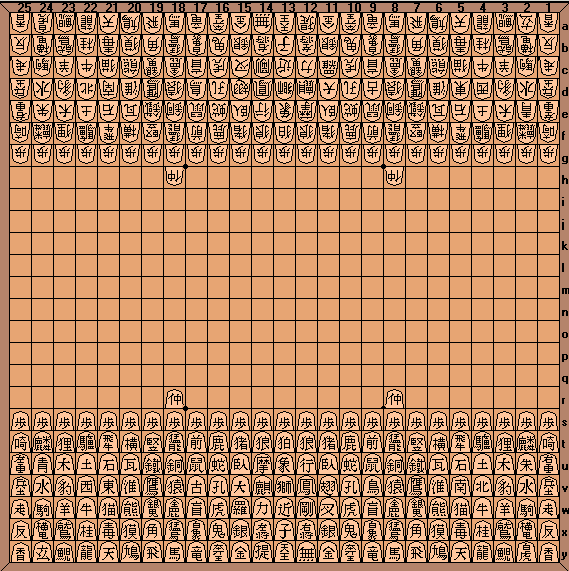Tai Shogi (Grand Shogi)
Tai Shogi or Mujotai Shogi (Grand Shogi) with its 25x25 square board and 354 pieces was thought to be the largest chess game in the world. (Actually, it is not!)
Tai Shogi is a gargantuan game both in terms of strategy and playing time. A serious game of Tai will require several long sessions to complete and may need over 1000 -moves per player. The game is simply too big to be played strategically, and therefore the game typically proceeds as a series of local skirmishes as both players try to develop their pieces and improve their position.
While most of the 101 different pieces in Tai Shogi are also found in other variants, one unique feature of Tai is the presence right from the beginning of the game of the all powerful Emperors.




(From Steve Evans)
SHORT DESCRIPTION:
Tai Shogi is played on a board of 25 x 25 squares and each player has 177 pieces (including 25 pawns) ! A unique feature of Tai Shogi is the presence right from the start of the game of the all powerful Emperors. The Emperor has the greatest power of any piece in any of the Shogi variants as it may move in one turn to almost any square on the board, jumping over any number of pieces of either side in the process.
While you might think that the power of the Emperors would have a great impact on the course of the game, their powers tend to offset each other. It should be noted that any otherwise unprotected piece is always protected by its own Emperor.
SPECIFIC RULES:
The Kylin, Phoenix, Donkey, Poisonous Snake and Knight (and the Emperor and those pieces with Lion powers) have the power to jump over occupied squares.
In Tai Shogi there are no restrictions on the capture of Lions (as there are in Chu Shogi).
The original hook mover in Tai Shogi is
the Peacock which is a hook mover in the forward diagonal
directions only, and can move one or two squares
along the backward diagonals.
In Tai Shogi there is a Crown Prince in the game at the start of play and this piece must be captured (along with the Emperor) before the game is won. In addition, the Drunk Elephant can also be promoted to a second Crown Prince. If this occurs both Crown Princes (and Emperor) must be taken before the game is ended.
A unique feature of Tai Shogi is the presence right from the start of the game of the all powerful Emperors. The Emperor has the greatest power of any piece in any of the Shogi variants as it may move in one turn to almost any square on the board, jumping over any number of pieces of either side in the process. The only restriction on the movement of the Emperor is that it may not capture an enemy piece that is protected by another piece. It is this rule which prevents the Emperor from simply capturing the opposing Emperor (or Crown Prince) on its first move.
While you might think that the power of the Emperors would have a great impact on the course of the game, their powers tend to offset each other. It should be noted that any otherwise unprotected piece is always protected by its own Emperor.
The promotion rules in Tai Shogi is a promotion by capture as in Dai Dai Shogi and other large cousins).
Unlike in Shogi, captured pieces in Tai can not be dropped back into play. A captured piece is removed from play and takes no further part in the game.
HISTORY:
The exact date Tai Shogi was invented is not known. It has the same history as Dai Dai Shogi and Maka Dai Dai Shogi. It was probably invented in the 15th century as it was included in Shogi rokushu no zushiki. However the oldest account that has survived until today of how the pieces moved was the 1694 publication of Nishzawa Teijin’s Sho Shogi Zushiki.
The fact that this game has been really played has been
questioned. However, it is known that 4 sets were actually
fabricated by Minase, a piece maker, in 1602. So, they
were few players.






